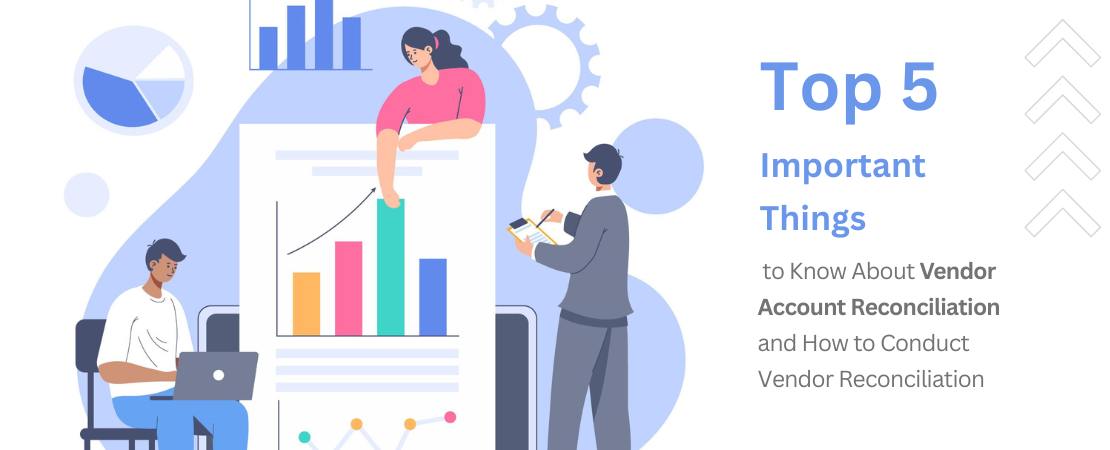Top 5 Important Things to Know About Vendor Account Reconciliation and How to Conduct Vendor Reconciliation
Does your company work with many vendors? If yes, vendor payments might be accounting for a substantial cash outflow in your company. But do you have someone who is taking care of vendor reconciliations? If not, you should probably make sure that it is done soon.
So, Let's know about vendor reconciliation?
Vendor accounts reconciliation is
a key procure-to-pay (P2P) control that has been designed as a routine key
compliance process by many organizations. It has been implemented to reduce the
risk of invalid liabilities held in the balance sheet and to have control over
vendors that have huge debit balances.
Usually,
Account Payable (AP) managers conduct a reconciliation of vendor statements to
make the process simple. This task can be really time-consuming and tedious.
But it offers many benefits and is often overlooked without understanding the
potential loss the company might incur in the process.
While
there could be multiple reasons for differences in the accounting of
transactions in the books by either of the parties, below are some of the root
causes for differences that appear in the reconciliation of vendor accounts.
→
Transparency in the accounting of invoices, payments and receipts
→
Identification of double payment/ excess payments/ Short payment made to
vendors
→
Resolution of disputed Invoices and debit notes and credit notes
→
Tracking of incorrect application of receipts by the vendor
→
Sales returns accounting by either of the parties
→
Discounts not accounted for correctly
→
Advances / Retention amount not adjusted properly in vendor account
→
TDS and other taxes not accounted correctly by the vendor
→
Routine signoff of reconciliation ensures clean accounting
Have
you felt that your company faces similar issues when it comes to vendor
accounts and payments? If so, you should definitely implement vendor account
reconciliation.
Before
we get into the details, here’s what a vendor statement is:
A
vendor statement is a document that a company receives from its vendors. This
document might consist of the details of all the unpaid invoices. It usually
contains credit notes and payments.
Now
that we have made it clear what vendor statements are, let’s look at what we
will discuss in this article:
1. What
is vendor reconciliation?
2. Why
should you reconcile vendor statements?
3. What
are the advantages of vendor reconciliations?
4. How
do you conduct vendor reconciliation?
5. Why
should you reach out to us for vendor reconciliations?
Let’s
get started by knowing more about vendor reconciliations.
1. What
is vendor reconciliation?
If
your organization has several vendors, the majority of your cash outflow will
be for these vendors. The vendors will keep an account of all the unpaid bills
they have. A vendor statement is a document from the vendor’s
accounting system listing all unpaid invoices at a certain date. It could also
contain other uncleared items such as credit notes and payments.
Reconciliation
of this vendor statement requires matching the invoices and other lines to
documents from your own system. Unmatched documents are discrepancies and
comprise the vendor statement reconciliation report. All of the possible issues
with your vendor account are represented in this single report.
2. Why
should you reconcile vendor statements?
A
lot of companies do not reconcile vendor statements. It is a time-consuming and
tedious task. But it is important to get this done. If the process for vendor
reconciliation is in place, the company accountants can finally sleep in peace!
The
vendor reconciliation process for any business requires matching the invoices
and other line-ups to documents. Failing to properly execute the vendor
reconciliation process may result in unmatched records are discrepancies, which
may further comprise the vendor statement reconciliation report.
Now
let us look at the advantages of vendor reconciliation.
3. What
are the advantages of vendor reconciliations?
With
effective vendor reconciliation, every company can ensure that no discrepancy
or hindrances arise when it comes to managing third-party, and other related
business associates. This is important to maintain vendor relationships for a
long period.
Here
are some advantages of performing vendor reconciliation:
i. Any
issue in the handling of invoices or bills can upset future stock and lose
settlement limits. In case, any recognizable proof of seller invoice or bill
can't be found, associations should demand the merchant to resend the reports
which brings about deferred installments.
Additionally,
if bills get recorded for mistaken merchants in the bookkeeping framework, your
business ends up paying some unknown seller. What's more, when the right vendor
questions it, the company may likewise pay this merchant, subsequently copying
the installment and bringing about bookkeeping blunders
Such
copy instalments can be kept away by coordinating with solicitations to the
seller's assertions. Regardless of whether merchant compromise is just handled
after instalment, the copies can be distinguished. In this way, you can do
whatever it may take to fix the mistakes.
ii. Companies
may end up overpaying on the off chance that their framework's seller
evaluating ace information is mistaken, or on the other hand if the merchant
receipt got caught at a wrong cost.
While
preparing the receipt, there are chances that accessible limits may get
mistakenly discarded. In this way, coordinating with the merchant details on
the framework to the seller articulation will either forestall or if nothing
else distinguish such excessive charges.
4. How
do you conduct vendor reconciliation?
While
there are several benefits associated with reconciling vendor statements every
month, it can be a really tiring task. Just imagine matching thousands of
invoices and other documents! If you are to do this manually, there is a lot of
printing, and cross-checking involved. The amount of time it will consume is
more than you can imagine. Despite this, there are chances of errors because
after all, how long can someone stay focused?
To
avoid these problems from cropping up, you need to digitize vendor
reconciliation so that you get a report that you can manually supervise.
Here
are some ways to reconcile vendor statements:
i.
You should choose vendor statement formats
Suppliers
or vendors can share invoices and statements in several formats. This is
because each vendor system will produce a different format or layout. You may
receive some vendor statements via email in Excel or PDF formats. But, you may
also have vendors who will send you physical copies of the statements.
Vendor statement reconciliation can
be a nightmare if you have the statements in so many different formats because
you will have to constantly keep referring to different formats. To avoid this,
you need to first choose a format that all vendor statements should be in. But
before you decide on the format, here’s what you should do.
ii.
You should know your outsourcing partner
As
mentioned earlier, it is not easy to conduct vendor reconciliation in an
organization. It is a very time-consuming and difficult task. Given this, you
can reach out to other companies that focus on vendor reconciliation and other
accounting services. These companies may even have software that will help you
and your employees a lot of time and energy.
So,
once you finalize your outsourcing partner or software, you will be clear about
the vendor statement format you require. This is because a lot of software will
only accept certain formats. This makes it easier for you to decide on the
required format.
Once
you have decided on the format, you can inform your vendors to share the
invoices and statements in that specific format. If not, you will have to type
in a lot of details into the system.
Check
out the next section to know how we can help you.
5. Why
should you reach out to us for vendor reconciliations?
If
you are seeking help with vendor reconciliations, we would like to tell you
that your search ends here. With us, you get end-to-end solutions for vendor
reconciliation.
We
offer reconciliation services in the below-given categories:
1. Vendors
2. Customers
3. Modern
trade, and,
4. E-commerce
Since
we are focusing on vendor account reconciliations, we will tell you the
categories of your vendor partners we can help with:
1. Material
suppliers
2. Service
providers
3. Logistics
partners
4. Utility
vendors
5. HR
contractors
6. Facility
management vendors
We
follow very systematic approaches when it comes to our services. And that’s
precisely why you should outsource one of the most important tasks in your company
to us.
Want
to know the benefits of outsourcing your vendor account reconciliation to us?
You
can check out the points below:
→
We offer our services at a competitive cost with quality comparable to top ITES
companies
→
Significant reduction in processing time
→
Seamless information flow providing visibility to vendors as well
→
Improved cash management
→
End-to-end tracking of documents
→
Robust accrual process
→
Query management and document audit trail
→
Real-time monitoring through CTM
Now, that you know why you should outsource the most time-consuming and service difficult tasks to us, We at AjayKumar and Associates assist our clients with precise vendor account reconciliation service.

